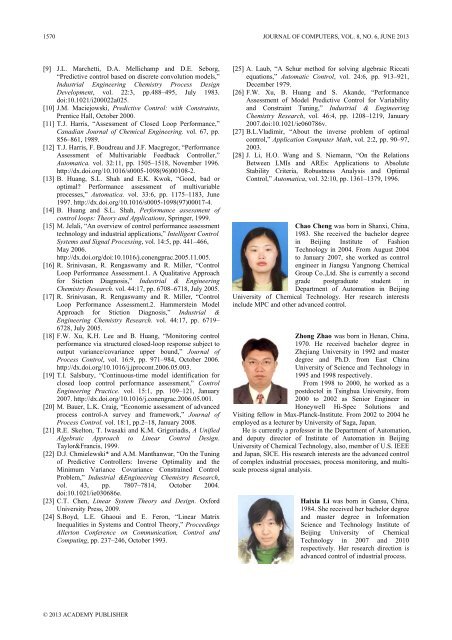Download Full Issue in PDF - Academy Publisher
Download Full Issue in PDF - Academy Publisher
Download Full Issue in PDF - Academy Publisher
Create successful ePaper yourself
Turn your PDF publications into a flip-book with our unique Google optimized e-Paper software.
1570 JOURNAL OF COMPUTERS, VOL. 8, NO. 6, JUNE 2013<br />
[9] J.L. Marchetti, D.A. Mellichamp and D.E. Seborg,<br />
“Predictive control based on discrete convolution models,”<br />
Industrial Eng<strong>in</strong>eer<strong>in</strong>g Chemistry Process Design<br />
Development, vol. 22:3, pp.488–495, July 1983.<br />
doi:10.1021/i200022a025.<br />
[10] J.M. Maciejowski, Predictive Control: with Constra<strong>in</strong>ts,<br />
Prentice Hall, October 2000.<br />
[11] T.J. Harris, “Assessment of Closed Loop Performance,”<br />
Canadian Journal of Chemical Eng<strong>in</strong>eer<strong>in</strong>g. vol. 67, pp.<br />
856–861, 1989.<br />
[12] T.J. Harris, F. Boudreau and J.F. Macgregor, “Performance<br />
Assessment of Multivariable Feedback Controller,”<br />
Automatica. vol. 32:11, pp. 1505–1518, November 1996.<br />
http://dx.doi.org/10.1016/s0005-1098(96)00108-2.<br />
[13] B. Huang, S.L. Shah and E.K. Kwok, “Good, bad or<br />
optimal Performance assessment of multivariable<br />
processes,” Automatica. vol. 33:6, pp. 1175–1183, June<br />
1997. http://dx.doi.org/10.1016/s0005-1098(97)00017-4.<br />
[14] B. Huang and S.L. Shah, Performance assessment of<br />
control loops: Theory and Applications, Spr<strong>in</strong>ger, 1999.<br />
[15] M. Jelali, “An overview of control performance assessment<br />
technology and <strong>in</strong>dustrial applications,” Intelligent Control<br />
Systems and Signal Process<strong>in</strong>g, vol. 14:5, pp. 441–466,<br />
May 2006.<br />
http://dx.doi.org/doi:10.1016/j.conengprac.2005.11.005.<br />
[16] R. Sr<strong>in</strong>ivasan, R. Rengaswamy and R. Miller, “Control<br />
Loop Performance Assessment.1. A Qualitative Approach<br />
for Stiction Diagnosis,” Industrial & Eng<strong>in</strong>eer<strong>in</strong>g<br />
Chemistry Research. vol. 44:17, pp. 6708–6718, July 2005.<br />
[17] R. Sr<strong>in</strong>ivasan, R. Rengaswamy and R. Miller, “Control<br />
Loop Performance Assessment.2. Hammerste<strong>in</strong> Model<br />
Approach for Stiction Diagnosis,” Industrial &<br />
Eng<strong>in</strong>eer<strong>in</strong>g Chemistry Research. vol. 44:17, pp. 6719–<br />
6728, July 2005.<br />
[18] F.W. Xu, K.H. Lee and B. Huang, “Monitor<strong>in</strong>g control<br />
performance via structured closed-loop response subject to<br />
output variance/covariance upper bound,” Journal of<br />
Process Control, vol. 16:9, pp. 971–984, October 2006.<br />
http://dx.doi.org/10.1016/j.jprocont.2006.05.003.<br />
[19] T.I. Salsbury, “Cont<strong>in</strong>uous-time model identification for<br />
closed loop control performance assessment,” Control<br />
Eng<strong>in</strong>eer<strong>in</strong>g Practice. vol. 15:1, pp. 109–121, January<br />
2007. http://dx.doi.org/10.1016/j.conengrac.2006.05.001.<br />
[20] M. Bauer, L.K. Craig, “Economic assessment of advanced<br />
process control-A survey and framework,” Journal of<br />
Process Control. vol. 18:1, pp.2–18, January 2008.<br />
[21] R.E. Skelton, T. Iwasaki and K.M. Grigoriadis, A Unified<br />
Algebraic Approach to L<strong>in</strong>ear Control Design.<br />
Taylor&Francis, 1999.<br />
[22] D.J. Chmielewski* and A.M. Manthanwar, “On the Tun<strong>in</strong>g<br />
of Predictive Controllers: Inverse Optimality and the<br />
M<strong>in</strong>imum Variance Covariance Constra<strong>in</strong>ed Control<br />
Problem,” Industrial &Eng<strong>in</strong>eer<strong>in</strong>g Chemistry Research,<br />
vol. 43, pp. 7807–7814, October 2004.<br />
doi:10.1021/ie030686e.<br />
[23] C.T. Chen, L<strong>in</strong>ear System Theory and Design. Oxford<br />
University Press, 2009.<br />
[24] S.Boyd, L.E. Ghaoui and E. Feron, “L<strong>in</strong>ear Matrix<br />
Inequalities <strong>in</strong> Systems and Control Theory,” Proceed<strong>in</strong>gs<br />
Allerton Conference on Communication, Control and<br />
Comput<strong>in</strong>g, pp. 237–246, October 1993.<br />
[25] A. Laub, “A Schur method for solv<strong>in</strong>g algebraic Riccati<br />
equations,” Automatic Control, vol. 24:6, pp. 913–921,<br />
December 1979.<br />
[26] F.W. Xu, B. Huang and S. Akande, “Performance<br />
Assessment of Model Predictive Control for Variability<br />
and Constra<strong>in</strong>t Tun<strong>in</strong>g,” Industrial & Eng<strong>in</strong>eer<strong>in</strong>g<br />
Chemistry Research, vol. 46:4, pp. 1208–1219, January<br />
2007.doi:10.1021/ie060786v.<br />
[27] B.L.Vladimir, “About the <strong>in</strong>verse problem of optimal<br />
control,” Application Computer Math, vol. 2:2, pp. 90–97,<br />
2003.<br />
[28] J. Li, H.O. Wang and S. Niemann, “On the Relations<br />
Between LMIs and AREs: Applications to Absolute<br />
Stability Criteria, Robustness Analysis and Optimal<br />
Control,” Automatica, vol. 32:10, pp. 1361–1379, 1996.<br />
Chao Cheng was born <strong>in</strong> Shanxi, Ch<strong>in</strong>a,<br />
1983. She received the bachelor degree<br />
<strong>in</strong> Beij<strong>in</strong>g Institute of Fashion<br />
Technology <strong>in</strong> 2004. From August 2004<br />
to January 2007, she worked as control<br />
eng<strong>in</strong>eer <strong>in</strong> Jiangsu Yangnong Chemical<br />
Group Co.,Ltd. She is currently a second<br />
grade postgraduate student <strong>in</strong><br />
Department of Automation <strong>in</strong> Beij<strong>in</strong>g<br />
University of Chemical Technology. Her research <strong>in</strong>terests<br />
<strong>in</strong>clude MPC and other advanced control.<br />
Zhong Zhao was born <strong>in</strong> Henan, Ch<strong>in</strong>a,<br />
1970. He received bachelor degree <strong>in</strong><br />
Zhejiang University <strong>in</strong> 1992 and master<br />
degree and Ph.D. from East Ch<strong>in</strong>a<br />
University of Science and Technology <strong>in</strong><br />
1995 and 1998 respectively.<br />
From 1998 to 2000, he worked as a<br />
postdoctol <strong>in</strong> Ts<strong>in</strong>ghua University, from<br />
2000 to 2002 as Senior Eng<strong>in</strong>eer <strong>in</strong><br />
Honeywell Hi-Spec Solutions and<br />
Visit<strong>in</strong>g fellow <strong>in</strong> Max-Planck-Institute. From 2002 to 2004 he<br />
employed as a lecturer by University of Saga, Japan.<br />
He is currently a professor <strong>in</strong> the Department of Automation,<br />
and deputy director of Institute of Automation <strong>in</strong> Beij<strong>in</strong>g<br />
University of Chemical Technology, also, member of U.S. IEEE<br />
and Japan, SICE. His research <strong>in</strong>terests are the advanced control<br />
of complex <strong>in</strong>dustrial processes, process monitor<strong>in</strong>g, and multiscale<br />
process signal analysis.<br />
Haixia Li was born <strong>in</strong> Gansu, Ch<strong>in</strong>a,<br />
1984. She received her bachelor degree<br />
and master degree <strong>in</strong> Information<br />
Science and Technology Institute of<br />
Beij<strong>in</strong>g University of Chemical<br />
Technology <strong>in</strong> 2007 and 2010<br />
respectively. Her research direction is<br />
advanced control of <strong>in</strong>dustrial process.<br />
© 2013 ACADEMY PUBLISHER
















